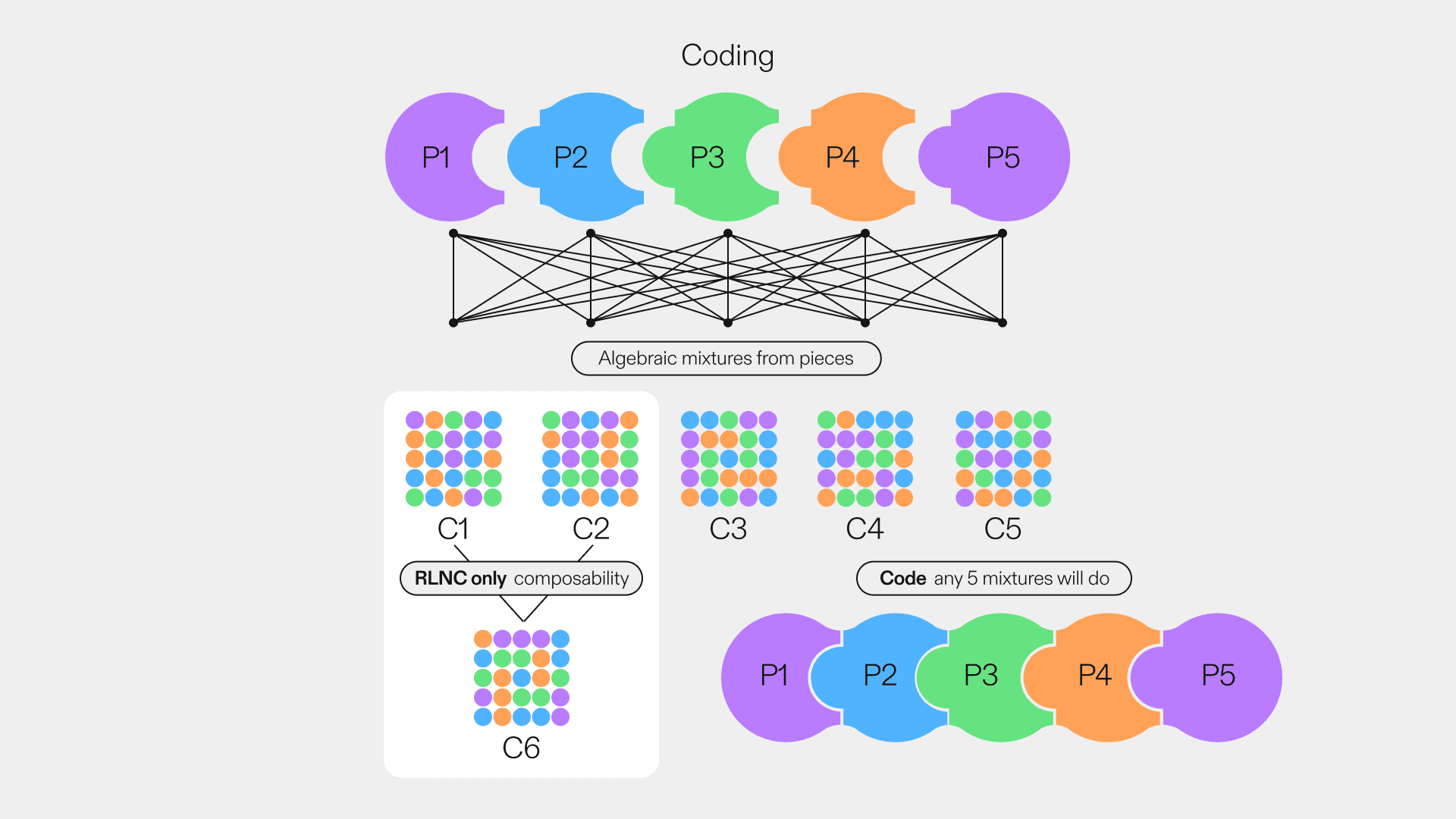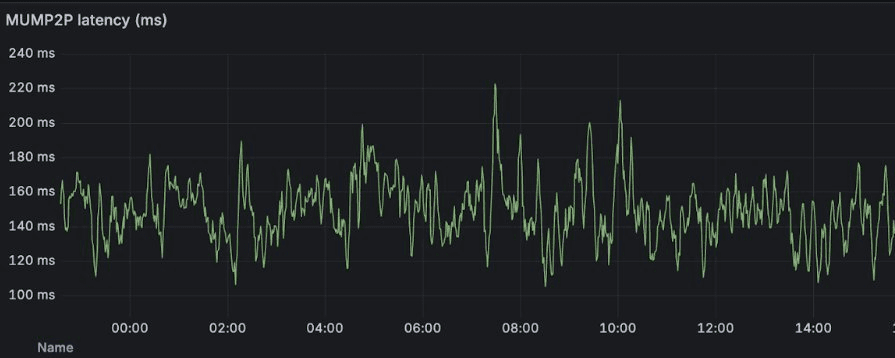Intro
Ever wonder why your transaction takes so long to confirm, even on a “fast” network? It turns out the culprit isn’t just block time or throughput, it’s how information spreads across the network. Most blockchains rely on gossip protocols to propagate transactions and blocks between nodes. Just like rumors spreading in a crowd, this “gossip” approach has an inherent bottleneck that slows down confirmations. To understand the problem (and how to fix it), let’s first look at how gossip works using a simple analogy, then look at how OptimumP2P applies Random Linear Network Coding (RLNC) to remove that bottleneck.
The Schoolyard Rumor Analogy: How Gossip Protocols Work
Picture a high school where one student starts a juicy rumor. They tell two friends, who each tell two more, and so on. In the beginning, the rumor spreads exponentially, after each round of gossip, roughly twice as many people know the story. This is analogous to a blockchain gossip protocol: when a new transaction or block is created, a node shares it with a few peers, each of whom relays it to others in turn. Early on, information spreads rapidly because almost every person (or node) you tell is hearing it for the first time. In technical terms, these first few “hops” across the network reach many new nodes quickly, achieving fast initial propagation.
Early efficiency: During this initial phase, gossip is remarkably efficient. The flood of unique rumors means lots of new receivers each round. In a blockchain network, this translates to low latency for the first 50–90% of nodes receiving a new block or transaction. For example, Ethereum’s gossip network (using the Gossipsub protocol) can propagate a new block to a majority of nodes in a second or two under normal conditions. This redundancy and parallelism gives gossip protocols strong fault tolerance and quick early coverage. In a small network or tight-knit group, everyone might hear the news almost immediately.
Fast at First, Then not: Gossip’s “Last Mile” Bottleneck
The trouble comes near the end of the rumor’s journey. Once most people have heard the gossip, it becomes harder to find someone new who hasn’t heard it. In our school analogy, by the time the rumor has circulated widely, many attempts to spread it are redundant – e.g. Dave tries to tell Frank, only to find Frank already heard it from Alice. The last few people in the school to hear the rumor end up getting it much later, because so many interactions are wasted repeating information. In networking terms, as a message propagates through a large peer-to-peer network, an increasing fraction of bandwidth is spent sending duplicate data to nodes that have already received it. The closer you get to everyone knowing the rumor, the more inefficient the process becomes. In short, the last piece of gossip is the hardest to spread.On a blockchain, this “last mile” of propagation is where gossip slows to a crawl. Every new peer a node contacts is likely to respond, “I already have that transaction/block.” Nodes keep rebroadcasting anyway (to ensure reliability), which means a lot of bandwidth and time goes into sending data that isn’t needed. The larger the network grows, the worse this redundancy gets – leading to significant delays in achieving full network-wide awareness of new data. In fact, the standard gossip approach that works fine for 10 nodes can bog down considerably with 10,000 nodes. As networks scale, gossip does not scale linearly, latency spikes and throughput hits a ceiling. The rumor that spread quickly in one classroom might take far longer to reach every student in a 100-class school. This is why a blockchain with thousands of nodes may see diminishing returns in performance as more nodes join: the gossip overhead grows faster than the benefits of added bandwidth.
Real-World Impact: Slow Confirmations and Network Congestion
How does this gossip bottleneck translate to the blockchain user’s experience? In practice, slow propagation can wreak havoc on performance and user expectations:
- Slower finality and confirmations: Even if block production is fast, the network can’t agree on new blocks until they’ve been widely propagated. For example, Ethereum’s consensus requires blocks to be known by most validators to finalize. It currently takes about 2 epochs (\~12.8 minutes) for Ethereum to finalize a block – in part because it gives the network time to gossip the data around to everyone. The gossip lag is effectively built into these safety delays.
- Forks and orphaned blocks: If a block doesn’t reach some miners or validators in time, those nodes might produce a competing block without knowing about the first. This leads to stale blocks or temporary forks in the chain. It’s well-known that two blocks mined almost simultaneously are often caused by network latency in propagation. The blockchain eventually resolves the conflict (one block becomes an uncle), but in the meantime, transactions in the orphaned block are delayed and network effort is wasted.
- Transactions lingering in mempools: The gossip problem doesn’t only affect blocks; transaction propagation can also lag. A transaction broadcast by your wallet has to gossip through the network before miners/validators include it. If the network is busy or your node is poorly connected, your transaction might sit in mempools waiting to be noticed. This contributes to network congestion and unpredictable confirmation times. Essentially, the blockchain can’t act on what it doesn’t know about. The slower the gossip, the more unevenly transactions are spread across the network’s mempools – some validators might get spammed with duplicates of popular txs, while others learn of them late.
In summary, the traditional gossip protocol becomes a scalability choke point. It’s not just theoretical – it manifests as slower block finalization, higher odds of temporary forks, and delays for users. No matter how fast your consensus mechanism or how high your throughput, if the data can’t efficiently reach all corners of the network, you’ll be stuck waiting.On a highly decentralized network like Ethereum, data has to reach more than 9,000 full nodes and 560K active validators for finality, putting the limitations of traditional gossip on full display.
Enter RLNC: A New Way to Spread Data (Solving the Gossip Problem)
RLNC replaces the “send-the-whole-block-to-every-peer” pattern with a coded-chunk approach. Instead of broadcasting identical copies, each node sends a small, linearly-combined fragment of the original data. Any node that gathers a sufficient number of distinct fragments can solve the resulting linear system and reconstruct the full block or transaction set.
Because each fragment is a compact algebraic mix, the payload is much smaller than the full message, and—crucially—every fragment a node receives is new information until decoding is complete. That means:
- No redundant traffic: bandwidth is used to deliver entropy, not duplicates.
- Last-mile solved: even the slowest or least-connected nodes receive enough unique fragments to finish decoding without waiting for a perfect, duplicate-free path.
- On-the-fly recoding: intermediate nodes can remix the fragments they hold and forward fresh combinations without first decoding, removing multi-hop loss accumulation and keeping throughput high at any network size.
In short, RLNC turns propagation from a bandwidth-hungry flood into a lean algebraic stream, eliminating the scale-driven latency that plagues traditional gossip.This is the fundamental advantage RLNC brings over standard gossip: every transmission is lightweight and informative. There’s no redundancy — each packet carries novel content until the message is decoded. That leads to much more efficient use of bandwidth, particularly in networks with limited capacity or unreliable links.This RLNC explainer breaks down the principle with a clean visual.
Another major benefit is recoding. Unlike traditional erasure codes like Reed-Solomon, where a node must fully decode before it can re-encode and forward, RLNC allows on-the-fly recombination. Nodes can simply mix the coded packets they’ve received to generate new ones — no need to reconstruct the original data first. Here’s a comparison showing why RLNC outperforms in multi-hop, high-loss environments.
Conclusion: Scaling Beyond Gossip
The takeaway is that the slow confirmations on blockchains are often a data propagation problem – the “gossip protocol problem” – rather than just a consensus problem. Gossip protocols ensure reliability, but at a high cost in latency as networks grow. Random Linear Network Coding provides a path to break through this bottleneck, by making each bit of communication count. Faster propagation means quicker consensus, fewer orphaned blocks, and a better experience for users waiting on transactions.
By fixing how data “gossip” spreads, we can drastically reduce confirmation times without sacrificing decentralization.
So next time you’re wondering why your transaction is taking a while, remember: it might just be stuck in slow gossip.
Blockchains no longer need rumor‑mill networking; with RLNC they can speak in compact, loss‑proof code.




